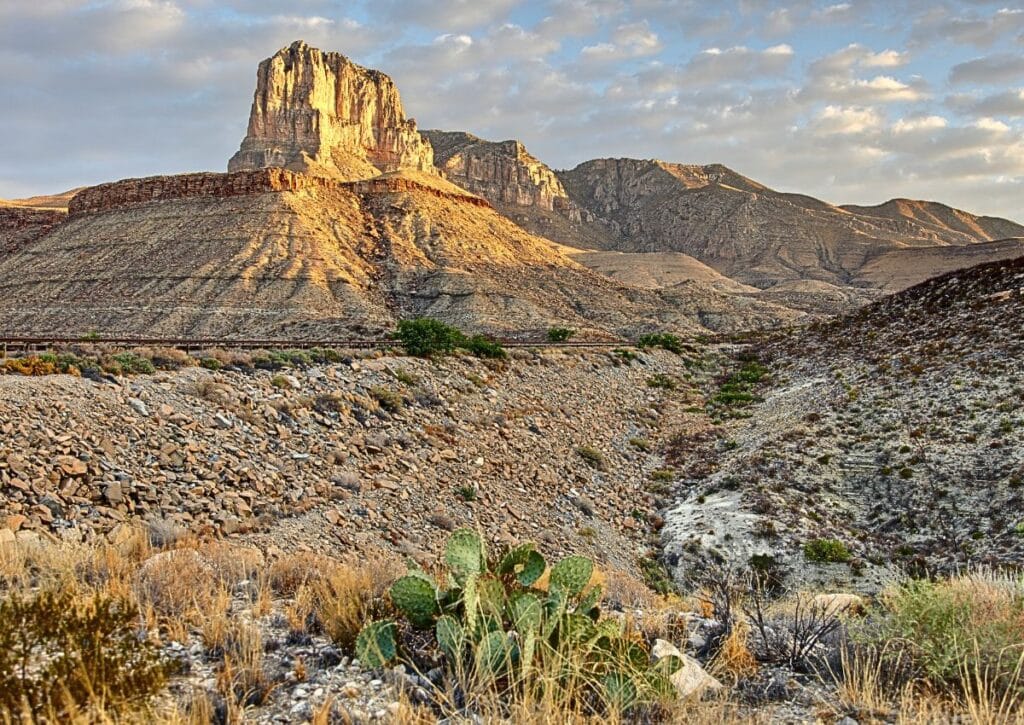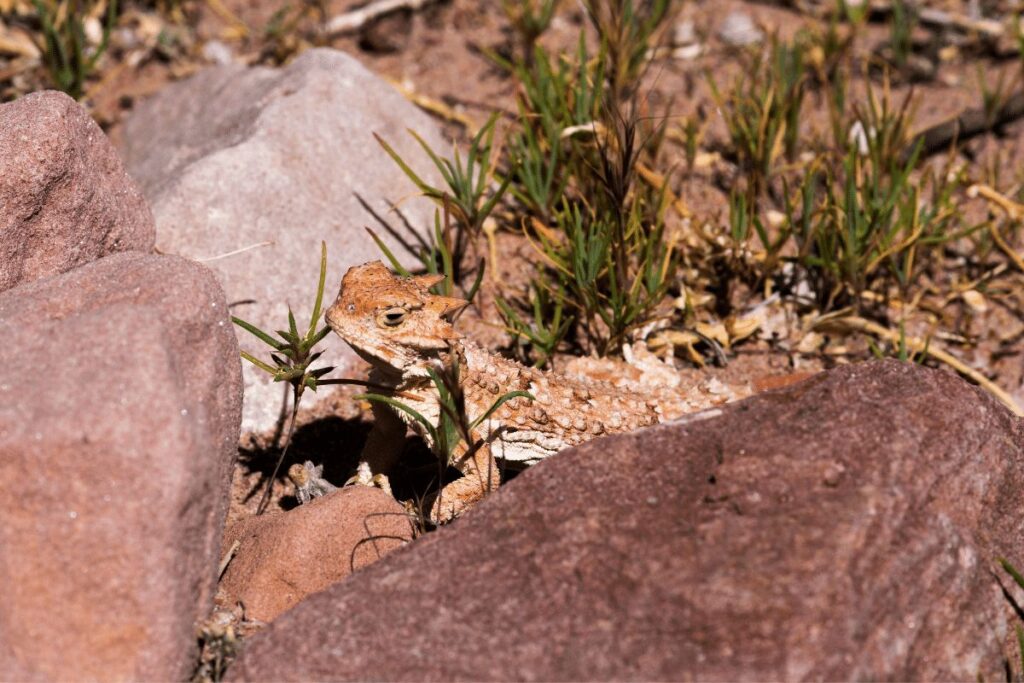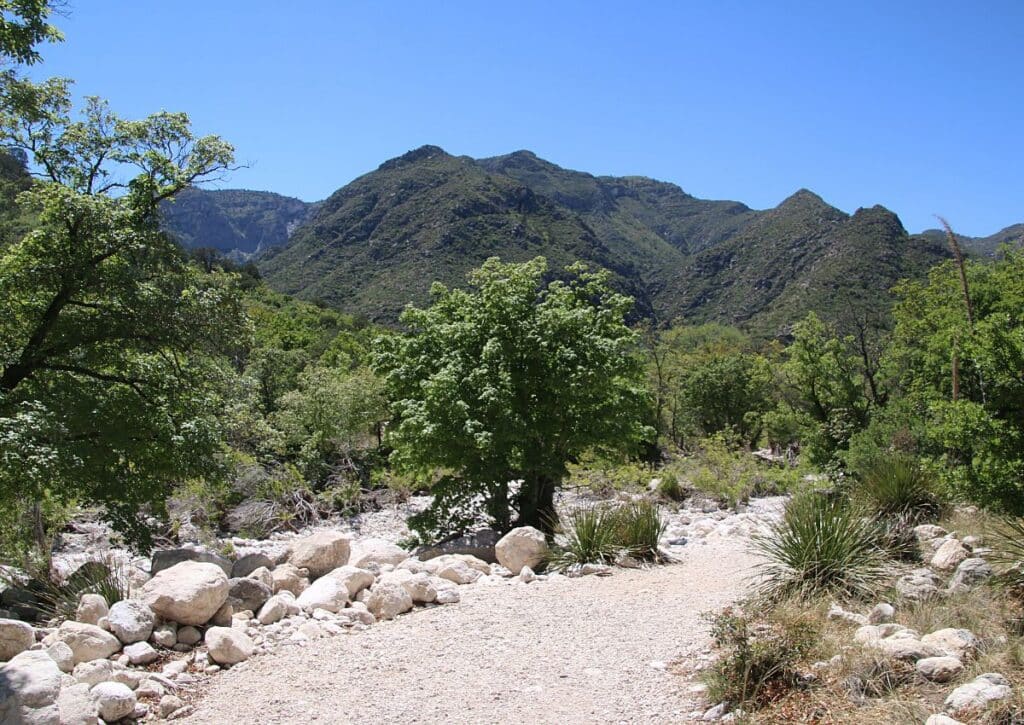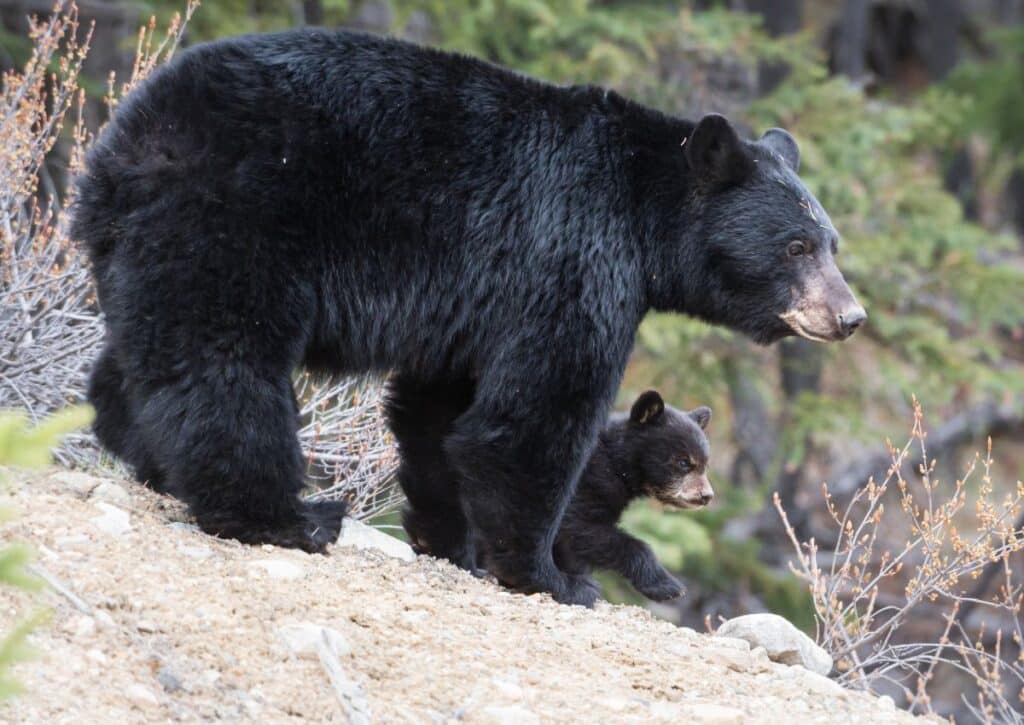Explore 11 hikes in Guadalupe Mountains National Park, teeming with wildlife. Your ultimate guide to trails and nature encounters.
Get ready to lace up and dive into an adventure in the Guadalupe Mountains National Park, where hiking trails become epic expeditions and wildlife encounters are just part of the experience.
This isn’t your average stroll through nature—each path offers a chance to play peek-a-boo with roadrunners, eavesdrop on the songs of Mexican jays, and maybe even lock eyes with a stealthy mountain lion.
With 11 top trails ranging from the peak-conquering challenge of Guadalupe Peak to the serene beauty of the Salt Basin Overlook, you’re in for a trekking treat packed with animal encounters.
This guide isn’t just about getting from A to B; it’s about the wild encounters in between. So, grab your gear and get set for a hiking saga where spotting a mule deer is as much a goal as reaching the summit.
Welcome to a hiker’s paradise where every trail tells a story and every footprint leads to a new adventure in the wild.
Guadalupe Peak Trail (Hard)
Towering above the Texan landscapes, the Guadalupe Peak Trail offers an experience like no other. As the highest point in Texas, it’s a journey that encapsulates the very essence of the Guadalupe Mountains National Park, presenting hikers with a challenging ascent rewarded by views that are nothing short of breathtaking.
Length: Approximately 8.4 miles round trip.
Difficulty: Hard. It’s a steep hike that requires a good level of fitness, but the payoffs are worth every drop of sweat!
Trailhead: Located at Pine Springs Campground, the well-marked trailhead provides ample parking space and essential information for hikers.
Sites on the Trail: As you embark on this ascent, you’re treated to a diverse array of sceneries. Initially, the trail meanders through a lush forested area, gradually giving way to exposed ridges.
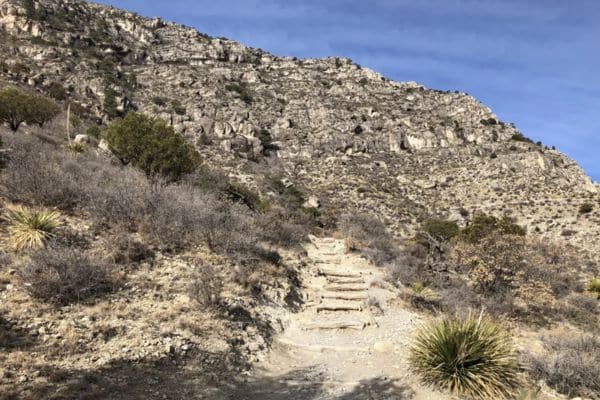
About halfway up, hikers encounter a breathtaking cliff, often referred to as the “false summit,” which provides a panoramic view of the park.
Upon reaching the peak, a stainless-steel pyramid commemorates the U.S. Mail stagecoach that traveled below during the 1850s.
Of course, the crowning glory is the 360-degree view from the summit, encompassing vast desert landscapes, salt flats, and neighboring peaks.
Wildlife Encounters: The Guadalupe Peak Trail, given its varied terrains, offers ample opportunities to spot diverse wildlife. Birds, particularly, are a highlight. As you begin your hike, keep an eye out for the vibrant Mountain Bluebirds and the cheeky Mexican Jays.
Raptors, such as the Red-tailed Hawks, often soar overhead, especially around the cliff areas. The more forested sections might surprise you with fleeting glimpses of mule deer or the occasional wild turkey.
As you ascend to rockier terrains, look out for the well-camouflaged Rock Squirrels or listen for the distinct calls of the Canyon Wren.
Remember, while the trail might test your stamina, taking frequent breaks not only helps you recover but also increases your chances of delightful wildlife encounters.
To Summarise: The Guadalupe Peak Trail is not just a hike; it’s an adventure. It promises unparalleled views, a rich tapestry of ecosystems, and the thrill of standing atop Texas’s highest point.
Just ensure you’re adequately prepared, both in terms of fitness and equipment, and you’re in for an experience of a lifetime!
Devil’s Hall Trail (Moderate)
The Devil’s Hall Trail beckons hikers with its unique blend of rugged desert beauty and geological wonders.
This trail, while moderately challenging, unravels nature’s art gallery, showcasing an impressive array of rock formations and the stunning “Hiker’s Staircase”.
Ideal for those who prefer a shorter trail without compromising on the park’s essence, Devil’s Hall is a journey into the heart of the Guadalupe Mountains’ geology.
Length: Approximately 4.2 miles round trip.
Difficulty: Moderate. While not as strenuous as some other trails, sections with boulder hopping require careful navigation.
Trailhead: Begins at the Pine Springs Campground, with clear signage directing hikers towards the trail’s start.
Sites on the Trail: The trail starts by gently winding through a picturesque pine forest. As you progress, the pathway narrows, leading into a rocky wash. This section requires navigating through boulders, adding a fun element of exploration to the hike.
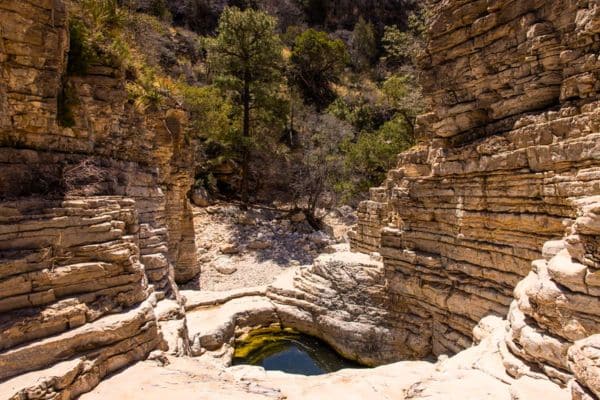
The main attraction, the “Hiker’s Staircase,” is a naturally occurring, stair-like rock formation, leading up to the Devil’s Hall, a narrow canyon flanked by vertical limestone walls.
The play of sunlight on these walls, coupled with the sheer beauty of the surrounding formations, makes for an ethereal setting that’s a photographer’s dream.
Wildlife Encounters: While the Devil’s Hall Trail is celebrated for its geology, it doesn’t fall short on wildlife offerings. The initial piney sections are frequented by birds like the Acorn Woodpecker and Pine Siskin.
As you venture into the rockier areas, you might be lucky enough to spot a Collared Lizard basking on the sunlit stones. The elusive Ringtail Cat has also been known to frequent this area, mostly during the quieter times of day.
Vegetation along the trail, such as the agaves and yuccas, often attract hummingbirds, darting around in a flash of iridescent colors. Throughout the trail, always be on the lookout for signs of wildlife, be it a track, a call, or a shadow darting across your path.
To Summarise: The Devil’s Hall Trail is an encapsulation of what the Guadalupe Mountains National Park stands for – a harmonious blend of nature’s artistry and its vibrant, living inhabitants.
Whether you’re a geology aficionado, a wildlife enthusiast, or simply someone seeking a memorable hike, this trail promises to leave a lasting impression.
McKittrick Canyon Trail (Moderate)
McKittrick Canyon Trail stands out as one of the most scenic trails in the Guadalupe Mountains National Park, renowned for its exceptional fall colors, especially when the maples turn brilliant shades of red and gold.
This canyon trail provides hikers with a rich display of both the park’s geology and its varied ecosystems.
Length: Roughly 14.8 miles round trip to McKittrick Ridge, but many opt for the shorter 4.8-mile round trip to Pratt Cabin or the 6.8-mile round trip to the Grotto.
Difficulty: Moderate, but the length can make it challenging for some. It’s essential to assess how far you wish to venture.
Trailhead: Located at the McKittrick Canyon Visitor Center, ample parking is available.
Sites on the Trail: The trail kicks off with a gradual climb through the beautiful wooded canyon floor.
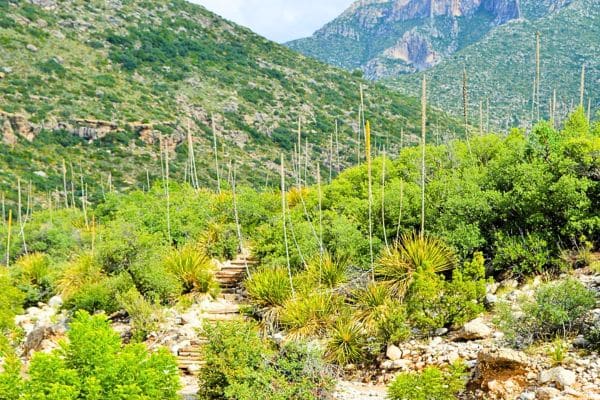
As hikers progress, they’re greeted by the historical Pratt Cabin, built with local stone, offering a great resting spot with picturesque views of the surrounding canyon.
Further along lies the Grotto, a unique rock formation with a picnic area.
Those venturing beyond this point will climb steeper terrains leading to the McKittrick Ridge, providing panoramic views of the surrounding wilderness.
Wildlife Encounters: McKittrick Canyon is rich in wildlife. Birdwatchers can expect sightings of species like the Painted Redstart, Broad-tailed Hummingbird, and the Rufous-crowned Sparrow.
The lower, wetter sections of the trail offer opportunities to spot the non-venomous Black-necked Garter Snake and the more elusive White-tailed Deer.
As the trail ascends and the vegetation becomes sparser, one might see Rock Squirrels and even hear the distinctive calls of the Canyon Wren. The varied plant life, especially during the fall, attracts diverse butterfly species, adding splashes of color to the already vibrant landscape.
To Summarise: McKittrick Canyon Trail, with its mix of fascinating sites and diverse wildlife, is a must-hike in the Guadalupe Mountains National Park.
Whether you’re aiming for the short hike to Pratt Cabin or pushing to the ridge, prepare for a trail rich in natural beauty and wildlife encounters.
El Capitan Trail (Moderate)
One of the most iconic landmarks within the Guadalupe Mountains National Park is El Capitan, a massive limestone formation that can be seen for miles around.
The El Capitan Trail provides adventurers with a chance to experience this majestic peak up close, offering a combination of expansive desert views, deep canyons, and the grandeur of El Capitan itself.
Length: Approximately 11.3 miles round trip.
Difficulty: Moderate, with some steep inclines and rugged sections.
Trailhead: The trail begins at the Pine Springs Campground, ensuring easy accessibility for those staying overnight.
Sites on the Trail: Beginning on the Tejas Trail, hikers are led through a varied landscape before branching off onto the El Capitan Trail.
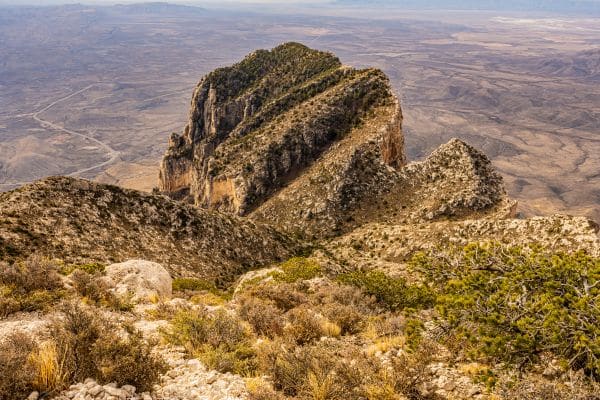
As you navigate through the Guadalupe Mountains’ diverse terrains, you’re treated to sweeping views of the surrounding area, including the park’s signature peak, Guadalupe Peak.
But the true reward is the up-close encounter with El Capitan itself. As the trail winds around this imposing formation, one gets a sense of its sheer scale and majesty.
Several vantage points along the way offer opportunities for panoramic photographs, especially during sunrise or sunset when the light paints the landscape in warm hues.
Wildlife Encounters: Given the trail’s varied landscapes, it’s a hotspot for wildlife. Bird enthusiasts can look forward to spotting species such as the Scott’s Oriole, the Ladder-backed Woodpecker, and occasionally even Golden Eagles riding the thermals above.
The desert scrub and canyons along the trail are home to creatures like the Desert Cottontail, the Black-tailed Jackrabbit, and even the Collared Peccary.
Reptile enthusiasts should keep an eye out for the Greater Earless Lizard sunning on rocks, and with some luck, the Trans-Pecos Rat Snake might make an appearance.
Always be mindful of your surroundings, as the occasional Western Diamondback Rattlesnake can also be found in these terrains.
In a nutshell, the El Capitan Trail offers a balanced experience of both challenging hiking and rewarding sights. While the trail demands respect and preparation, the intimate encounter with one of Texas’s most iconic peaks makes every step worth it.
Remember to carry ample water, wear sturdy footwear, and take frequent breaks to fully absorb the beauty that this trail has to offer.
Frijole and Foothills Trail (Moderate)
The Frijole and Foothills Trail is a synthesis of rolling terrains, unique vegetation, and the serene ambiance of the Chihuahuan Desert environment.
As a moderate hike, this trail is suitable for adventurers who crave a comprehensive taste of the park’s diverse landscapes without the steepness of some of the more challenging routes.
Length: Combined, the trails offer approximately 6.2 miles round trip.
Difficulty: Moderate, with some undulating terrains but generally approachable for those with basic hiking experience.
Trailhead: Initiates at the Pine Springs Campground, easily distinguishable by trail markers.
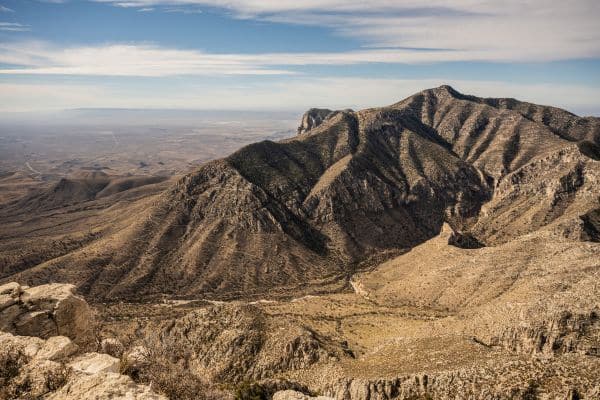
Sites on the Trail: The journey commences through the Frijole Trail, introducing hikers to a dense, lush canyon abundant with Ponderosa Pines and Bigtooth Maples.
As the path intertwines with the Foothills Trail, the landscape transitions, revealing vast expanses of desert foothills dotted with agaves and yuccas.
Hikers are often enchanted by the Frijole Ranch History Museum along the way – a preserved ranch that offers a glimpse into the region’s rich past.
Beyond this, the trail gracefully meanders through pockets of woodland and open desert, ensuring a varying visual feast with each step.
Wildlife Encounters: The trail’s unique blend of foothills and woodland is a magnet for diverse wildlife.
Birdwatchers can anticipate sightings of the vibrant Western Bluebird, the agile Black-throated Sparrow, and the melodious Canyon Towhee.
Among the foliage, especially during dawn or dusk, hikers might catch sight of Mule Deer, while the more elusive Gray Fox might be observed prowling in the underbrush.
The plant life, particularly the flowering desert succulents, attracts various pollinators, from buzzing bees to the iridescent Black-chinned Hummingbird.
As with all desert environments, caution is advised; one might encounter reptiles such as the harmless Greater Short-Horned Lizard or the more cautious Western Diamondback Rattlesnake.
In Short: The Frijole and Foothills Trail presents hikers with a well-rounded experience, encapsulating the rich biodiversity and landscapes of the Guadalupe Mountains National Park.
While navigating this trail, it’s recommended to wear sun protection, ensure adequate hydration, and periodically halt, listen, and observe—the desert, after all, is alive with more stories and sightings than the untrained eye might first perceive.
Permian Reef Trail (Hard)
The Permian Reef Trail is more than just a hiking route; it’s a journey back in time. This trail provides an incredible geologic exploration into the ancient remnants of a reef that existed during the Permian period.
As one of the more challenging trails in the Guadalupe Mountains National Park, it offers an unbeatable blend of physical exertion, captivating views, and an outdoor geology lesson.
Length: Approximately 8.4 miles round trip.
Difficulty: Hard. The steep inclines and rugged terrains demand a good level of fitness and preparation.
Trailhead: The trail starts at the McKittrick Canyon Visitor Center, and clear markers guide the way.
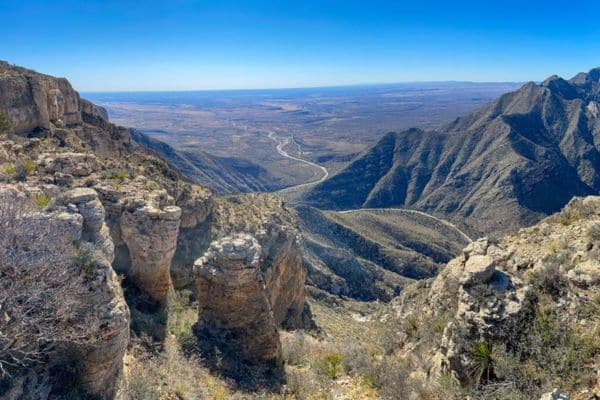
Sites on the Trail: From the onset, the trail treats hikers to an array of fossilized remnants from the Permian Sea, dating back around 250-280 million years.
As you ascend, strategically placed markers delineate various geologic formations, offering insights into the ancient marine life and sedimentary patterns.
The higher elevations grant panoramic vistas of McKittrick Canyon, and on a clear day, one can see as far as the salt flats in West Texas.
Geology enthusiasts will especially appreciate the “wilderness geology exhibit” along the trail, providing detailed explanations of the area’s geologic history.
Wildlife Encounters: Despite its emphasis on geology, the Permian Reef Trail doesn’t disappoint when it comes to wildlife encounters. The trail’s varied altitude gradients support a rich mix of fauna.
The lower sections, with their dense brush, are often frequented by White-tailed Deer and the sporadic Javelina. As the path winds upwards, one might catch a glimpse of the nimble Aoudad (Barbary Sheep) skillfully navigating the rocky outcrops.
Birds, including the Red-tailed Hawk, Peregrine Falcon, and even the occasional Golden Eagle, can often be seen soaring against the backdrop of the vast blue sky.
Among the rocks, reptiles like the Collared Lizard and the Desert Striped Whipsnake find their home, offering exciting spotting opportunities for the keen observer.
To Summarize: The Permian Reef Trail is an unparalleled blend of challenging hiking, ancient geology, and diverse wildlife.
Tackling this trail requires stamina, adequate hydration, and a respect for the delicate balance of nature.
As you traverse its length, you’re not just walking a path but retracing the steps of Earth’s ancient history, making every exertion completely worth the effort.
Lost Peak Trail (Moderate)
Lost Peak Trail stands as a testament to the serene and untouched beauty of the Guadalupe Mountains National Park.
This trail offers hikers an immersive experience into both dense woodland and expansive vistas, culminating at the iconic Lost Peak — a vantage point that provides sweeping panoramas of the surrounding landscapes.
Length: Roughly 6.4 miles round trip.
Difficulty: Moderate. While the trail involves certain steep sections, they are well interspersed with flatter terrains, making it approachable for most hikers.
Trailhead: The hike begins from the Pine Springs Campground, with clear indications leading the way.
Sites on the Trail: Embarking on the Lost Peak Trail, hikers first encounter wooded terrains, dotted with Alligator Junipers and Emory Oaks, providing a canopy of shade and the whisper of leaves.
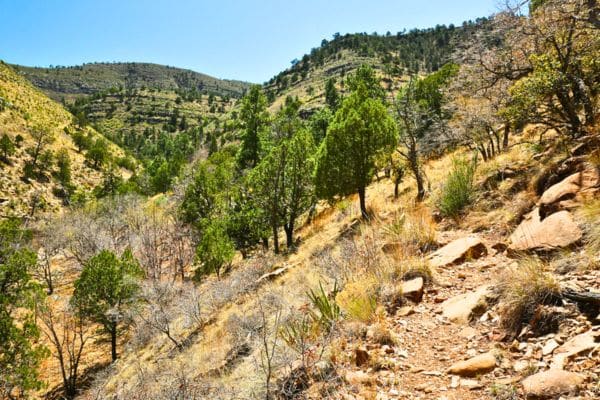
As the trail progresses, the woodland gradually gives way to more open areas, with the horizon expanding in every direction. One of the highlights of this hike is the final ascent to Lost Peak.
Standing at an elevation of 6,710 feet, Lost Peak offers a bird’s-eye view of the park, from the rolling foothills to the more formidable mountain ranges in the distance.
This peak, with its unobstructed views, is also a fantastic spot to catch a sunrise or sunset, painting the landscapes in hues of gold and crimson.
Wildlife Encounters: The diverse vegetation along the Lost Peak Trail offers habitat to an array of wildlife. The woodland sections are frequented by birds such as the Bridled Titmouse and the Acorn Woodpecker.
More open terrains, with their shrubs and grasslands, are perfect spots to observe ground-dwelling birds like the Scaled Quail. Among the foliage, Black-tailed Jackrabbits often make an appearance, their large ears a giveaway even from a distance.
For reptile enthusiasts, creatures like the Desert Horned Lizard and the Chihuahuan Whipsnake are occasionally spotted basking on sunlit rocks.
As always, while the fauna is a delight to observe, it’s essential to do so respectfully, ensuring their natural behaviors remain undisturbed.
In Short: The Lost Peak Trail offers a balanced hiking experience, combining the tranquility of woodlands with the grandeur of elevated vistas.
Whether you’re a first-time visitor to the Guadalupe Mountains National Park or a seasoned explorer, this trail promises new sights, sounds, and memories with every visit.
Ensure you’re equipped with adequate water, sun protection, and perhaps a camera – the sights from Lost Peak are worth capturing!
Bear Canyon Trail
Situated deep within the Guadalupe Mountains National Park, the Bear Canyon Trail is a hidden gem. This path, while less frequented by the casual visitor, presents an unmatched combination of raw challenge and natural splendor.
The steep ascent promises panoramic vistas and intimate experiences with the park’s diverse wildlife.
Length: 1.8 miles from the Frijole Trail junction to the top of Bear Canyon.
Difficulty: Being among the steepest in the park, it presents a rigorous climb but rewards with an unmatched sense of achievement.
Trailhead(s): Access is via the Frijole Trail, starting from either Pine Springs or Frijole Ranch.
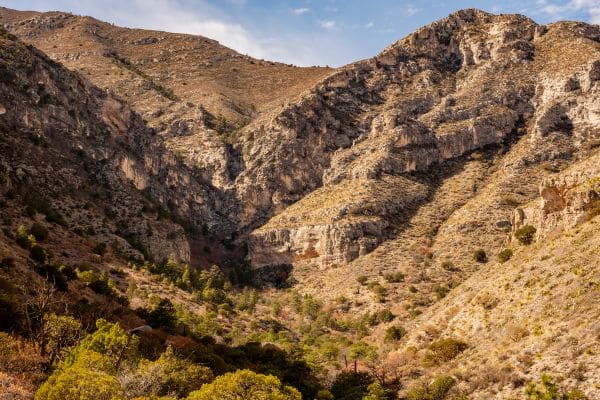
Sites on the Trail: The Bear Canyon Trail doesn’t waste any time introducing its steep gradient. As hikers progress, the expansive views of the Pine Springs region become more pronounced, offering a breathtaking perspective of the park’s sprawling landscapes.
Even though the trail directly faces the sun for a significant part of the day, patches of tree cover provide moments of shade, adding contrasting hues of green against the rocky backdrop.
Upon reaching the ridge, a junction with the Bowl Trail offers choices: continue the ascent to the majestic Hunter Peak or immerse oneself in the tranquil environment of the Bowl.
Wildlife Encounters: The trail’s seclusion often translates to rewarding wildlife encounters. Birdwatchers can anticipate sightings of the vibrant Western Tanager or the sharp-eyed Peregrine Falcon gliding overhead.
The shaded sections, with their cooler microclimate, are frequented by species like the Mexican Jay and the elusive Montezuma Quail. Ground-dwelling animals, such as the Rock Squirrel or even the more wary Ringtail, can be spotted during the quieter times of day.
The varied vegetation, from cacti to shrubs, attracts a host of insects, including butterflies like the Two-tailed Swallowtail.
As always, hikers should approach wildlife with respect and caution, maintaining a safe distance and ensuring their activities don’t disturb the animals’ natural behaviors.
To Summarize: The Bear Canyon Trail offers more than just a hike. It’s an experience, a test of endurance, and a window into the diverse ecosystems of the Guadalupe Mountains.
For those willing to take on its challenge, the trail promises a blend of natural beauty, wildlife encounters, and the satisfaction of conquering one of the park’s steepest paths.
Juniper Trail
Acting as a vital connector within the Guadalupe Mountains National Park, the Juniper Trail seamlessly binds the Bowl Trail to the Tejas Trail.
This moderately distanced trail invites hikers on a journey that not only serves as a conduit between major paths but also reveals an array of vistas, remnants of historical significance, and a verdant, forested ambiance.
Length: 2.0 miles, linking the Bowl junction to the Tejas junction.
Trailhead(s): The trail acts as a connector between the Bowl Trail and the Tejas Trail.
Sites on the Trail: Starting from the Bowl junction, the trail gradually unravels the expansive vistas of the bowl, providing panoramic views that change with every step.
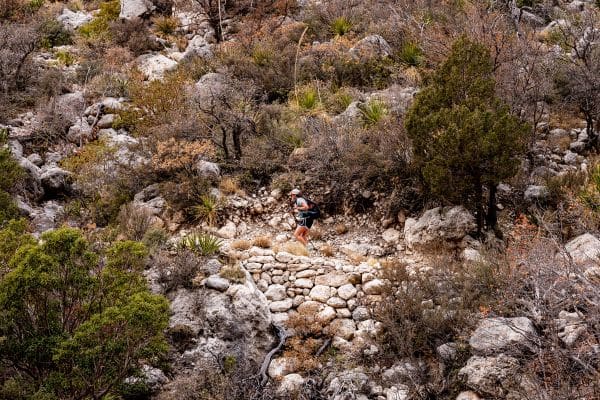
As hikers climb the ridge, they are treated to a different vantage point, offering an elevated perspective of the vast parkland below.
The descent, shrouded in a rich forest canopy, has its own charm, with the cool shade and the sounds of nature creating a serene ambiance.
Scattered along the trail, remnants of old ranches stand as silent witnesses to the region’s bygone days, offering a touch of history to the hike.
Wildlife Encounters: The Juniper Trail, with its mix of open vistas and dense forest, provides diverse habitats for a variety of wildlife. The open areas are often frequented by birds of prey like the Red-tailed Hawk or the Cooper’s Hawk, scouting for their next meal from above.
Within the forested sections, hikers might encounter the playful antics of the White-breasted Nuthatch or the melodic calls of the Mountain Chickadee.
The forest floor and undergrowth provide shelter for smaller mammals such as the Brush Mouse and the Cliff Chipmunk. Occasionally, traces of the larger Mule Deer might be spotted, especially around dawn or dusk.
Recap: The Juniper Trail, while primarily serving as a connector, offers its own unique set of experiences.
Whether it’s the sweeping views, the historical remnants, or the promise of wildlife encounters, this trail ensures that the journey between the Bowl and Tejas is as memorable as the destination.
When embarking on the Juniper Trail, hikers are advised to carry water, wear suitable footwear, and take moments to appreciate the diverse offerings of this distinctive pathway.
The Bowl Trail
Winding through the high country of the Guadalupe Mountains National Park’s Wilderness, The Bowl Trail is a captivating journey through varying terrains and elevations.
It offers not just the charm of a looped trail but also ushers hikers through a mosaic of views, ecosystems, and historical echoes.
Touted by many as an essential hike within the park, it provides an immersive experience into the area’s natural and historical richness.
Length: The loop has a total distance of 3.6 miles from the Pine Top junction, with various trail segments connecting to other notable trails and sites.
Trailhead(s): The trail connects the Tejas Trail at the Pine Top and Juniper junctions, circles back to the Bowl trail above the Pine Top junction, and links to the top of the Bear Canyon Trail, north of Hunter Peak.
Sites on the Trail: Beginning from the Pine Top junction, the trail gradually elevates, presenting expansive vistas of the Pine Springs Canyon and Bear Canyon.
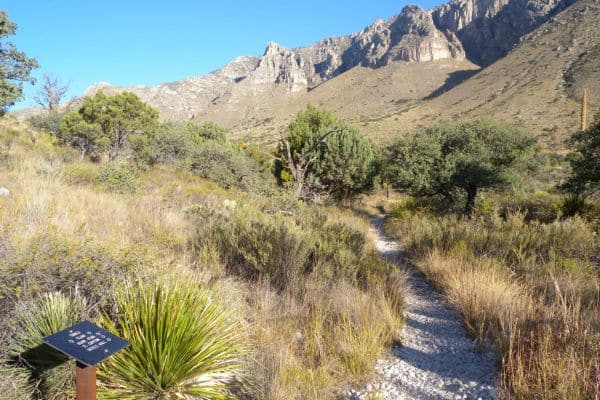
As the path winds further, hikers descend into the heart of the dense forested region famously known as the Bowl. The forest, with its cool shade and tranquil ambiance, contrasts beautifully with the open views from the escarpments.
One of the trail’s crowning jewels is the summit of Hunter Peak, offering panoramic views that many argue are the finest in the park.
Throughout the hike, keen eyes can spot the remnants of a bygone era — a ranch water system that once quenched the thirst of both man and cattle.
Wildlife Encounters: The varied terrains of The Bowl trail offer habitats for diverse wildlife. Within the Bowl area, the dense forest is a sanctuary for animals like deer and elk, which can occasionally be spotted grazing or seeking shade.
Birds, including the Grace’s Warbler and the Dark-eyed Junco, flit between the trees, adding their songs to the trail’s soundtrack. As the trail progresses and the vegetation changes, so does the wildlife.
From the high vantage points, one might spot raptors like the Swainson’s Hawk riding the thermals.
While the flora and fauna are delightful, the remnants of the old ranch water system serve as a testament to the human history of the region, reminding hikers of the land’s multifaceted narrative.
Summary: The Bowl trail, with its intricate network connecting various major trails and sites, is more than just a pathway — it’s a curated experience of what the Guadalupe Mountains National Park has to offer.
Whether you’re ascending to the peak, traversing through the dense Bowl, or pausing to understand the area’s history, every step on this trail provides a story.
Hikers should equip themselves with water, sun protection, and a sense of adventure to fully enjoy the wonders of The Bowl trail.
Salt Basin Overlook Trail
Serving as a spectacular diversion from the El Capitan Trail, the Salt Basin Overlook Trail offers hikers a unique opportunity to explore the depths of Guadalupe Canyon and the heights of mesa-like cliffs.
While moderate in its difficulty, the trail provides continuous scenic shifts, from the grandeur of El Capitan to the vast expanse of salt flats in the distance.
Length: The trail stretches for 3.6 miles from the east junction to the west junction, with a total loop distance of 11.3 miles from the Pine Springs Trailhead and back.
Difficulty: Moderate, with some challenging ascents and varying terrains.
Trailhead(s): The trail can be accessed at two points from the El Capitan Trail.
Sites on the Trail: Beginning where the El Capitan Trail meets Guadalupe Canyon, the Salt Basin Overlook Trail delves southward into the canyon’s embrace.
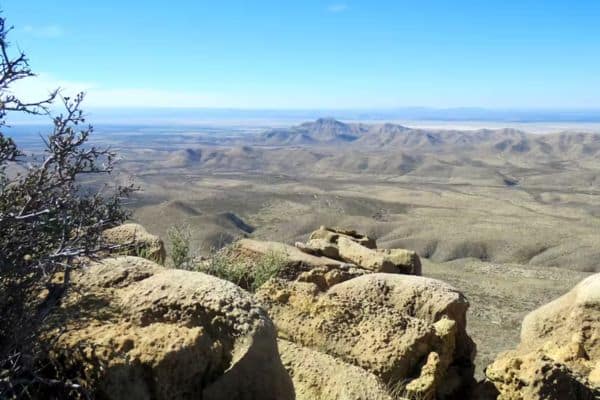
As hikers venture deeper, they’ll skirt around the tops of mesa-like cliffs, offering a bird’s-eye view of the rugged beauty below.
The trail’s path then challenges with a steep ascent, but the effort is soon rewarded with up-close vistas of the iconic El Capitan.
Further along, the trail opens up to reveal panoramic views of the salt flats to the south and west, shimmering under the sun and stretching to the horizon.
Wildlife Encounters: Given its varied landscapes, the Salt Basin Overlook Trail is a haven for diverse wildlife. The cliff areas and rockier terrains might be frequented by birds such as the Rock Wren or the Say’s Phoebe.
The lower sections, near the canyon, offer opportunities to spot mammals like the nimble Ringtail or even the nocturnal Western Spotted Skunk.
As the trail opens up towards the salt flats, hikers might observe birds adapted to more open terrains, such as the Horned Lark or the Mountain Plover.
As always, it’s essential to approach wildlife with respect and minimize disturbances.
Briefly: The Salt Basin Overlook Trail, with its unique diversions and vistas, is a testament to the varied beauty of the Guadalupe Mountains National Park.
Whether tackling the trail as a standalone hike or as part of a longer journey from the Pine Springs Trailhead, the sights and experiences it offers make every step worthwhile.
Ensure to be well-equipped, carry sufficient water, and prepare to be mesmerized by the trail’s ever-changing landscapes.
Wildlife in Guadalupe Mountains National Park
The Guadalupe Mountains National Park, with its dramatic peaks, winding trails, and ancient rock formations, is more than just a hiker’s paradise; it’s a testament to the vibrant tapestry of life that has evolved and thrived in this unique ecosystem.
As one navigates through this expansive terrain, the true depth of its biodiversity becomes overwhelmingly apparent, making it an invaluable treasure trove of natural wonders.
Biodiversity of the Park:
At the heart of the Guadalupe Mountains’ allure is its staggering array of wildlife, a beautiful confluence of species shaped by millennia of geological and climatic changes. From the subtle fluttering of wings overhead to the discreet tracks left behind on the trails, evidence of life is everywhere.
Bird enthusiasts will be particularly enthralled. The park plays host to a myriad of avian species, from the iconic roadrunner and Mexican jay to the more elusive birds of prey, like golden eagles and red-tailed hawks. Their calls, songs, and silhouettes add an unmatched vitality to the park’s expansive skies.
On the ground, the story is equally captivating. Creatures like mule deer, bighorn sheep, elk, and even the occasional mountain lion traverse the varied terrains of the Guadalupe Mountains.
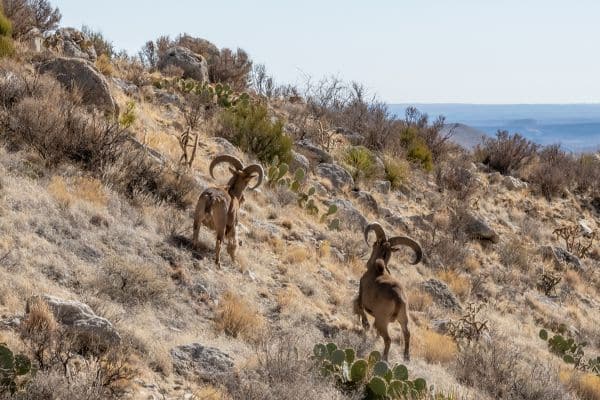
Along the rocky paths, one might spot lizards basking under the sun or even catch the flickering movement of snakes slithering into the shadows.
The park’s smaller inhabitants, such as rodents, insects, and amphibians, though less conspicuous, play just as crucial roles in this balanced ecosystem.
The plant life too, from hardy desert succulents to verdant pine forests, complements this biodiversity, offering sustenance and shelter to many of the park’s inhabitants.
Importance of Conservation in the Area:
Such an abundant ecosystem does not merely exist for our admiration; it serves as a poignant reminder of the delicate balance of nature and the responsibility we hold in ensuring its continued existence.
The Guadalupe Mountains National Park, like many natural reserves, faces its fair share of threats – from climate change and habitat destruction to the introduction of invasive species.
Conservation in the park isn’t just about preserving its current state; it’s about safeguarding a legacy for future generations. Every species, no matter how seemingly insignificant, plays a pivotal role in the intricate web of life that the park sustains.
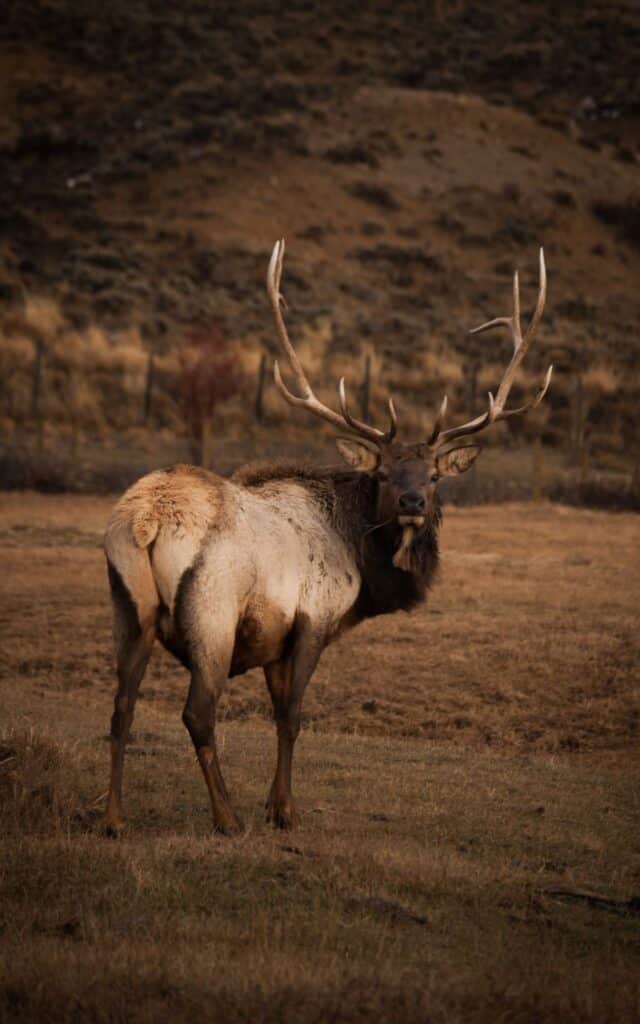
The loss or decline of even a single species could set off a cascade of changes, potentially destabilizing this fragile equilibrium.
Moreover, parks like Guadalupe Mountains serve as critical research hubs. Scientists and researchers delve deep into its terrains to understand not just the park’s ecology but also broader environmental patterns and changes.
Such insights can guide policies and conservation strategies, not only within the park but in similar ecosystems worldwide.
Conservation also has an intrinsic cultural and educational value. As visitors traverse the park’s trails, they don’t just witness nature; they learn about it.
They’re educated on the myriad ways in which every plant, animal, and rock is intertwined, fostering a deeper appreciation and a heightened sense of stewardship. By preserving the Guadalupe Mountains, we ensure that this living classroom remains open, continuing to inspire and educate.
The park’s conservation is essential for its local communities. Beyond the obvious economic contributions from tourism, these ecosystems offer invaluable services – from water filtration and climate regulation to being sources of traditional medicines and raw materials.
Preserving the park means preserving a lifeline for many.
Preparing for a Wildlife Hike
Venturing into the heart of nature, especially in a biodiverse haven like the Guadalupe Mountains National Park, can be an exhilarating experience. The anticipation of observing wildlife in its natural habitat is unparalleled.
However, the key to a memorable wildlife hike lies in preparation. Being equipped and knowledgeable ensures not only your safety but also that of the very creatures you’ve come to admire.
Tips for Respectful and Safe Wildlife Viewing:
Maintain a Safe Distance: As captivating as wildlife encounters can be, it’s crucial to remember that these animals are wild. For both their safety and yours, always maintain a respectful distance.
This ensures you don’t inadvertently stress or provoke them. As a rule of thumb, if the animal appears agitated or changes its behavior due to your presence, you’re too close.
Avoid Feeding the Animals: The food we carry, no matter how organic or harmless it may seem, isn’t suitable for wild animals.
Feeding wildlife not only poses health risks to them but can also make them accustomed to humans, potentially leading to aggressive behavior.
Stay Quiet: A serene demeanor increases your chances of spotting wildlife. Loud noises can disturb animals and drive them away. It’s always best to talk softly and tread lightly.
Stay on Marked Trails: While the allure of off-trail exploration can be tempting, sticking to marked trails reduces the risk of disturbing wildlife habitats. This ensures the creatures continue their daily routines undisturbed.
Leave No Trace: Ensure you carry back everything you bring. Littering not only despoils the pristine environment but can also pose severe hazards to wildlife.
Equipment Recommendations for Wildlife Spotting:
Binoculars: A good pair of binoculars is indispensable for wildlife enthusiasts. They allow you to observe animals from a safe distance without compromising on the details. Opt for a pair with a wide field of view and good magnification.
Field Guide: Carrying a regional field guide can enhance your experience. Being able to identify and learn about the creatures you encounter adds depth to your observations.
Notebook and Pen: Documenting your sightings can be both fun and informative. It helps in keeping track of species seen and their behaviors.
Camera with Zoom Lens: For those keen on capturing their wildlife encounters, a camera with a good zoom lens is essential. It allows for detailed shots without needing to approach the animals closely.
Comfortable Footwear: While this might seem obvious, wearing comfortable and sturdy footwear is essential. Rough terrains require shoes that offer good grip and ankle support.
Sun Protection and Hydration: Given the often sunny and dry conditions, it’s crucial to wear hats, sunglasses, and sunscreen. Additionally, always carry sufficient water to stay hydrated.
The beauty of a wildlife hike in the Guadalupe Mountains National Park is heightened when approached with respect and preparation.
Being mindful of our interactions and well-equipped not only ensures memorable encounters but also contributes to the continued well-being of the park’s incredible inhabitants.
What are the best hikes in Guadalupe Mountains National Park?
Guadalupe Mountains National Park boasts an array of hiking trails suitable for all experience levels. Among the best hikes are the Guadalupe Peak Trail, the highest point in Texas offering unparalleled views; the McKittrick Canyon Trail, known for its vibrant fall colors and a beautiful stream; The Bowl Trail, a loop offering panoramic views and dense forests; and Devil’s Hall Trail, a natural stairway amidst rocky formations. Each trail presents a unique perspective of the park’s diverse landscapes.
What is the best hike at Guadalupe State Park?
Guadalupe State Park, distinct from the national park, offers the Bald Cypress Trail as one of its highlights. This trail, popular for its scenic river views and accessibility, provides a perfect blend of the park’s natural beauty with the tranquility of the Guadalupe River.
Is it safe to hike in Guadalupe Mountains National Park?
Yes, hiking in Guadalupe Mountains National Park is generally safe. However, like all wilderness areas, it’s essential to be prepared. This includes checking the weather, carrying ample water, being aware of wildlife, and informing someone of your hiking plans. Additionally, staying on designated trails and avoiding solo hikes can further enhance safety.
How many days do you need in Guadalupe Mountains National Park?
A visit of 2-3 days is ideal for Guadalupe Mountains National Park. This allows visitors to tackle a few of the major trails, enjoy the scenic views, and perhaps camp for a night or two.
However, if one is looking for a more extensive exploration, including multiple hikes, bird-watching, and immersing in the park’s natural beauty, a longer stay of 4-5 days would be more suitable.
Is Guadalupe Peak a hard hike?
Yes, the Guadalupe Peak Trail is considered a challenging hike. Stretching over 8 miles round-trip, it involves a steep ascent of over 3,000 feet to reach the highest point in Texas. While the path is well-marked, its length and elevation gain make it strenuous. However, the panoramic views from the summit make the effort worthwhile.
Are there bears in Guadalupe Mountains National Park?
While the Guadalupe Mountains were historically home to black bears, they were extirpated from the region in the early 20th century. There have been occasional sightings in recent years, suggesting possible migrations from nearby regions, but encounters remain extremely rare.
Are there mountain lions in Guadalupe Mountains?
Yes, mountain lions, also known as cougars or pumas, are present in the Guadalupe Mountains. However, they are elusive creatures, and sightings are infrequent. Park visitors are advised to be aware of their surroundings, especially when hiking during dawn or dusk, and to follow safety guidelines to avoid potential encounters.
Conclusion
For the wildlife enthusiast gearing up for a hiking expedition, the Guadalupe Mountains National Park stands out as an unmissable destination.
From its diverse trail offerings that cater to both novices and seasoned hikers, to the rich tapestry of flora and fauna that call the park home, every step within this park promises a new discovery.
Whether it’s the challenging ascent to Guadalupe Peak, the serene ambience of the Bowl, or the historical remnants scattered across trails, there’s a story waiting at every bend.
It’s not just about the hike; it’s about immersing oneself in an environment where nature’s grandeur meets historical legacy.
As you plan your visit, equip yourself not just with hiking gear but also with a sense of adventure and respect for the wilderness.
The Guadalupe Mountains beckon with their mysteries, views, and wildlife encounters, guaranteeing memories that will last a lifetime.

